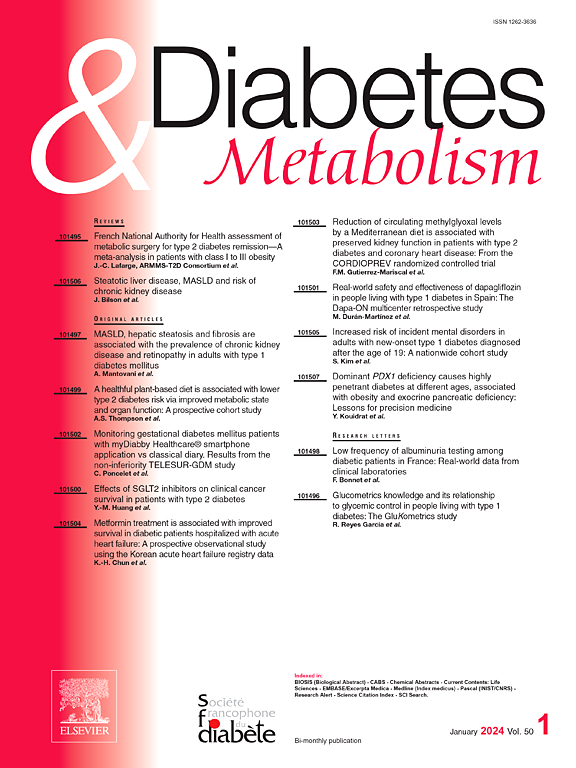一项随机对照试验:成人和青少年1型糖尿病患者持续皮下胰岛素输注进行两种有氧运动,运动前后策略对低血糖风险的影响
IF 4.7
2区 医学
Q1 ENDOCRINOLOGY & METABOLISM
引用次数: 0
摘要
目的:研究1型糖尿病(pwT1D)患者持续皮下胰岛素输注在不同有氧运动期间和之后降低低血糖风险的策略。研究设计与方法:37例pwT1D(成人21例,青少年16例;HbA1c = 7.5±1.0%)参加两次吸收后(餐后4小时)运动(60分钟连续中等强度[CONT]与间歇[INT])。运动前90分钟,运动前基础速率降低(BRR)为40%或80%。运动后,参与者要么在10小时内摄入20%的BRR,同时减少20%的晚餐量(INS),要么在运动后吃45克碳水化合物(CHO)零食,其中含有50%的胰岛素,然后在睡前吃30克CHO零食,但不含胰岛素(零食)。结果:虽然在两种运动方式中观察到的低血糖事件数量相似(31 vs 28),但与INT相比,CONT在运动期间导致的血糖下降幅度更大(-3.1±2.3,CONT vs -2.7±2.2 mmol/l, INT, P = 0.005)。运动期间的血糖变化(-3.0±2.4,40% brr vs -2.8±2.1 mmol/l, 80%BRR, P = 0.076)和低血糖事件次数(35 vs 24)在40%和80%BRR之间相似。在运动后的前30分钟,与零食相比,INS的高血糖时间更短,但在恢复后期或夜间没有观察到差异。结论:与INT相比,CONT导致更大的血糖下降,但未增加低血糖的风险。较大的运动前BRR并没有进一步降低运动期间低血糖的风险。运动后INS和零食策略导致pwT1D的葡萄糖谱相似。本文章由计算机程序翻译,如有差异,请以英文原文为准。

Impact of pre- and post-exercise strategies on hypoglycemic risk for two modalities of aerobic exercise among adults and adolescents living with type 1 diabetes using continuous subcutaneous insulin infusion: A randomized controlled trial
Objective
We investigated strategies to mitigate hypoglycemic risk during and after different aerobic exercises in people with type 1 diabetes (pwT1D) using continuous subcutaneous insulin infusion.
Research design and methods
Thirty-seven pwT1D (21 adults, 16 adolescents; HbA1c = 7.5 ± 1.0 %) participated in two post-absorptive (4-h post-meal) exercise sessions (60-min continuous moderate intensity [CONT] vs. intermittent [INT]). Pre-exercise basal rate reduction (BRR) was either 40 % or 80 %, 90 min before exercise. Post-exercise, participants undertook either a 20 % BRR for 10 h with 20 % reduced dinner bolus (INS) or a 45 g post-exercise carbohydrate (CHO) snack with a 50 % insulin bolus, and a 30 g bedtime CHO snack without bolus (snack).
Results
While a similar number of hypoglycemic events (31 vs. 28) were observed between exercise modalities, CONT led to a greater decrease in blood glucose during exercise compared to INT (-3.1 ± 2.3, CONT vs. -2.7 ± 2.2 mmol/l, INT, P = 0.005). Changes in blood glucose during exercise (-3.0 ± 2.4, 40 %BRR vs. -2.8 ± 2.1 mmol/l, 80 %BRR, P = 0.076) and the number of hypoglycemic events (35 vs. 24) were similar between 40 % and 80 %BRR. Time in hyperglycemia was lower with INS compared to snack in the first 30 min after exercise, but no differences were observed for late recovery period or nighttime.
Conclusion
Compared to INT, CONT led to greater blood glucose decline without increasing hypoglycemia risk. A larger pre-exercise BRR did not further reduce hypoglycemia risk during exercise. Post-exercise INS and snack strategies led to comparable glucose profiles in pwT1D.
求助全文
通过发布文献求助,成功后即可免费获取论文全文。
去求助
来源期刊

Diabetes & metabolism
医学-内分泌学与代谢
CiteScore
12.00
自引率
4.20%
发文量
86
审稿时长
13 days
期刊介绍:
A high quality scientific journal with an international readership
Official publication of the SFD, Diabetes & Metabolism, publishes high-quality papers by leading teams, forming a close link between hospital and research units. Diabetes & Metabolism is published in English language and is indexed in all major databases with its impact factor constantly progressing.
Diabetes & Metabolism contains original articles, short reports and comprehensive reviews.
 求助内容:
求助内容: 应助结果提醒方式:
应助结果提醒方式:


